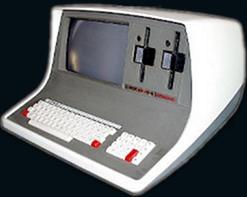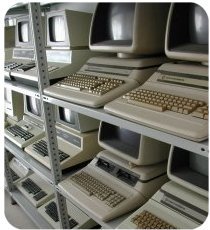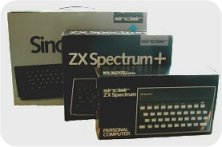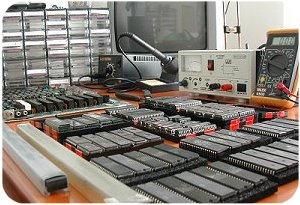 THE MUSEUM
THE MUSEUM
Hosted in the western part of Tuscany, a land rich in cultural traditions since ever and home to important experiences tied to the early days of computer science, the initiative has its main core in the collection of Dr. Eng. G.Lera. A collection gathered together in almost ten years of activity, numbering more than one thousand items concerning the Microcomputer Revolution and the history of personal computer. Various machines are present, along with peripherals, accessories, original programs on different media (tapes, disks, cartridges), books, manuals and magazines. Moreover, a few thousands vintage integrated circuits are also present, which constitute the main source of replacement parts. The initiative is privately managed and hosted: access is currently possible in virtual form through this site or in the event of external exhibitions. Exceptions are possible for institutions, hobbysts and technicians by appointment, depending on availabilty of the owners (for more information, please see Links & Contacts). The "PERSONAL AND HOME COMPUTER MUSEUM" intiative is completely no-profit, funded only by the fundamental ingredients of patience and passion.

 Care and correct preservation of machines that have more than two decades of life is a fundamental activity.
Whoever is into vintage computers must sooner or later face inevitable problems of space, which may lead to
store what's been acquired into garages, basements, warehouses where they may be attacked by environmental
conditions far from ideal: dust, moisture, too cold or too hot temperature (due, for example, to rooms not
heated in winter or subject to beating sun in summer) and unstable storage, may risk to thwart all the restoring
efforts so far carried out. For such reasons, a dedicated room has been set up for this collection. Here is a
description of the preservation guidelines applied.
Personal computers for business, all-in-one computers and peripherals weighing more than 5Kg: for those
machines, steel shelves painted with epoxidic resin and capable of taking 1200Kg per span have been set up.
Home computers, pocket computers and small sized machines: they are placed on solid pine shelves. Cleaning:
weekly room cleaning. After the initial cleaning, computers are subject to dust removal bi-weekly. Maintenance:
power-on every six months with 30 minutes burn-in to verify working status. Fruition: every machine can be moved
to the test table to be turned on, used or, when possible, to examine the internal structure. In
addition to the previous case, the machines temporarily leave their site in the event of external exhibitions.
Care and correct preservation of machines that have more than two decades of life is a fundamental activity.
Whoever is into vintage computers must sooner or later face inevitable problems of space, which may lead to
store what's been acquired into garages, basements, warehouses where they may be attacked by environmental
conditions far from ideal: dust, moisture, too cold or too hot temperature (due, for example, to rooms not
heated in winter or subject to beating sun in summer) and unstable storage, may risk to thwart all the restoring
efforts so far carried out. For such reasons, a dedicated room has been set up for this collection. Here is a
description of the preservation guidelines applied.
Personal computers for business, all-in-one computers and peripherals weighing more than 5Kg: for those
machines, steel shelves painted with epoxidic resin and capable of taking 1200Kg per span have been set up.
Home computers, pocket computers and small sized machines: they are placed on solid pine shelves. Cleaning:
weekly room cleaning. After the initial cleaning, computers are subject to dust removal bi-weekly. Maintenance:
power-on every six months with 30 minutes burn-in to verify working status. Fruition: every machine can be moved
to the test table to be turned on, used or, when possible, to examine the internal structure. In
addition to the previous case, the machines temporarily leave their site in the event of external exhibitions. The original boxes that come with our computers represent important extras.
While manuals and printed matter are, since ever, relevant testimonies and provide information about usage of a machine,
its applications and its target market, boxes and packages show how differently the manufacturers perceived their products:
to some, boxes were simple and basic cardboard receptacles, to others they were a first interface toward the customer
and to others they were a real marketing instrument transmitting the feeling of the product: serious, professional,
innovative, friendly, colorful etc...
Paper and cardboard are much more weak materials than plastics and metal, and they can be greatly affected by the
damages caused by moisture or bad preservation. For such reasons original packages, in addition to being treated in a way
similar to the computers, are protected using bags made of inert materials such as polypropylene or polyethylene which,
as opposed to other materials such as PVC, do not contain acids that may cause problems in the long run.
The original boxes that come with our computers represent important extras.
While manuals and printed matter are, since ever, relevant testimonies and provide information about usage of a machine,
its applications and its target market, boxes and packages show how differently the manufacturers perceived their products:
to some, boxes were simple and basic cardboard receptacles, to others they were a first interface toward the customer
and to others they were a real marketing instrument transmitting the feeling of the product: serious, professional,
innovative, friendly, colorful etc...
Paper and cardboard are much more weak materials than plastics and metal, and they can be greatly affected by the
damages caused by moisture or bad preservation. For such reasons original packages, in addition to being treated in a way
similar to the computers, are protected using bags made of inert materials such as polypropylene or polyethylene which,
as opposed to other materials such as PVC, do not contain acids that may cause problems in the long run. Restauration and repairs are some of the most fascinating activities, but also some of the most critical.
The first phase always features an accurate cleaning of external parts and, once disassembled, of internal ones.
Often those machines are acquired or donated with many years of dust and dirt inside and outside of them,
therefore the undergo careful washing with specific detergents depending on the part to treat:
kitchen detergents for plastics and painted metal, alcohol-based products for ink spots (if compatible with the paint of the case),
glass cleaners for CRTs etc... Repairs of external damages must be the least invasive possible, to avoid alterning the original state of the machine.
Such operations may include glueing broken parts, straightening bent parts and retouching using suitable paints
(but only when the area to be treated is very small, no more than a few millimeters, and when it possible to obtain
colours close enough to the original ones). In case of doubts about the results, it is always better to
leave the machine in the state it has arrived. Being computers almost always based on proprietary architectures,
repairs of electrical and electronic devices require a preliminary phase of study of techincal documentation and fault diagnosis,
followed by specific tests and, when possible, replacement of the component identified (or suspect) as defective.
For such reasons, we're constituting a stock of obsolete components numbering a few thousands pieces already.
During this phase though, experience is the most important component. That's why cooperation and support from skilled technicians is always welcome.
Restauration and repairs are some of the most fascinating activities, but also some of the most critical.
The first phase always features an accurate cleaning of external parts and, once disassembled, of internal ones.
Often those machines are acquired or donated with many years of dust and dirt inside and outside of them,
therefore the undergo careful washing with specific detergents depending on the part to treat:
kitchen detergents for plastics and painted metal, alcohol-based products for ink spots (if compatible with the paint of the case),
glass cleaners for CRTs etc... Repairs of external damages must be the least invasive possible, to avoid alterning the original state of the machine.
Such operations may include glueing broken parts, straightening bent parts and retouching using suitable paints
(but only when the area to be treated is very small, no more than a few millimeters, and when it possible to obtain
colours close enough to the original ones). In case of doubts about the results, it is always better to
leave the machine in the state it has arrived. Being computers almost always based on proprietary architectures,
repairs of electrical and electronic devices require a preliminary phase of study of techincal documentation and fault diagnosis,
followed by specific tests and, when possible, replacement of the component identified (or suspect) as defective.
For such reasons, we're constituting a stock of obsolete components numbering a few thousands pieces already.
During this phase though, experience is the most important component. That's why cooperation and support from skilled technicians is always welcome.
